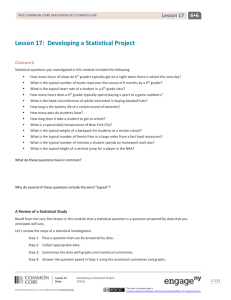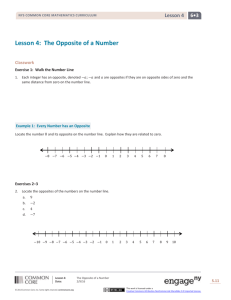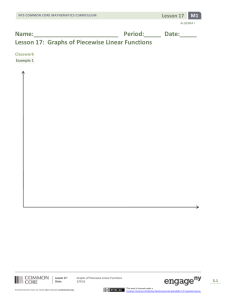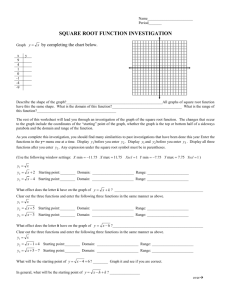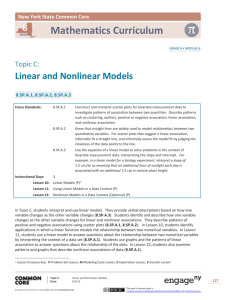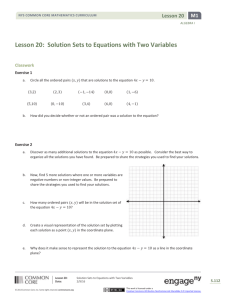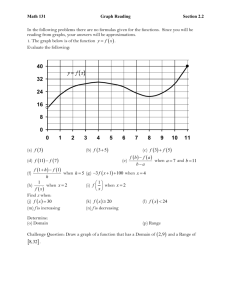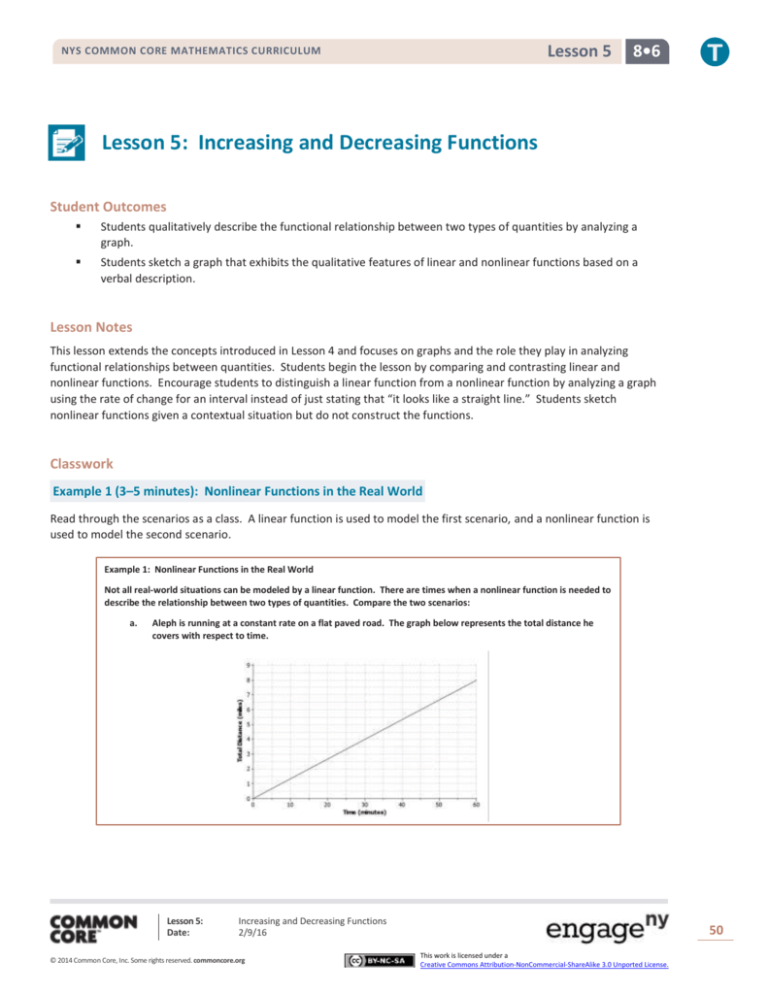
Lesson 5
NYS COMMON CORE MATHEMATICS CURRICULUM
8•6
Lesson 5: Increasing and Decreasing Functions
Student Outcomes
Students qualitatively describe the functional relationship between two types of quantities by analyzing a
graph.
Students sketch a graph that exhibits the qualitative features of linear and nonlinear functions based on a
verbal description.
Lesson Notes
This lesson extends the concepts introduced in Lesson 4 and focuses on graphs and the role they play in analyzing
functional relationships between quantities. Students begin the lesson by comparing and contrasting linear and
nonlinear functions. Encourage students to distinguish a linear function from a nonlinear function by analyzing a graph
using the rate of change for an interval instead of just stating that “it looks like a straight line.” Students sketch
nonlinear functions given a contextual situation but do not construct the functions.
Classwork
Example 1 (3–5 minutes): Nonlinear Functions in the Real World
Read through the scenarios as a class. A linear function is used to model the first scenario, and a nonlinear function is
used to model the second scenario.
Example 1: Nonlinear Functions in the Real World
Not all real-world situations can be modeled by a linear function. There are times when a nonlinear function is needed to
describe the relationship between two types of quantities. Compare the two scenarios:
a.
Aleph is running at a constant rate on a flat paved road. The graph below represents the total distance he
covers with respect to time.
Lesson 5:
Date:
Increasing and Decreasing Functions
2/9/16
© 2014 Common Core, Inc. Some rights reserved. commoncore.org
50
This work is licensed under a
Creative Commons Attribution-NonCommercial-ShareAlike 3.0 Unported License.
Lesson 5
NYS COMMON CORE MATHEMATICS CURRICULUM
b.
8•6
Shannon is running on a flat, rocky trail that eventually rises up a steep mountain. The graph below
represents the total distance she covers with respect to time.
Exercises 1–2 (5–7 minutes)
Students will be looking at the rate of change for different intervals for the scenarios presented in Example 1. Let
students work with a partner. Then, discuss answers as a class. Remind students of increasing, decreasing, and constant
linear functions from the previous lesson.
Why might the distance that Shannon runs during each 15 minute interval decrease?
Shannon is running up a mountain. Maybe the mountain is getting steeper, which is causing her to run
slower.
Are these increasing or decreasing functions?
They are both increasing functions because the total distance is increasing with respect to time. The
function that models Aleph’s total distance is an increasing linear function, and Shannon’s total
distance is an increasing nonlinear function.
Exercises 1–2
1.
In your own words, describe what is happening as Aleph is running during the following intervals of time.
a.
𝟎 to 𝟏𝟓 minutes
Aleph runs 𝟐 miles in 𝟏𝟓 minutes.
b.
𝟏𝟓 to 𝟑𝟎 minutes
Aleph runs another 𝟐 miles in 𝟏𝟓 minutes for a total of 𝟒 miles.
c.
𝟑𝟎 to 𝟒𝟓 minutes
Aleph runs another 𝟐 miles in 𝟏𝟓 minutes for a total of 𝟔 miles.
d.
𝟒𝟓 to 𝟔𝟎 minutes
Aleph runs another 𝟐 miles in 𝟏𝟓 minutes for a total of 𝟖 miles.
Lesson 5:
Date:
Increasing and Decreasing Functions
2/9/16
© 2014 Common Core, Inc. Some rights reserved. commoncore.org
51
This work is licensed under a
Creative Commons Attribution-NonCommercial-ShareAlike 3.0 Unported License.
Lesson 5
NYS COMMON CORE MATHEMATICS CURRICULUM
2.
8•6
In your own words, describe what is happening as Shannon is running during the following intervals of time.
a.
𝟎 to 𝟏𝟓 minutes
Shannon runs 𝟏. 𝟓 miles in 𝟏𝟓 minutes.
b.
𝟏𝟓 to 𝟑𝟎 minutes
Shannon runs another 𝟎. 𝟔 miles in 𝟏𝟓 minutes for a total of 𝟐. 𝟏 miles.
c.
𝟑𝟎 to 𝟒𝟓 minutes
Shannon runs another 𝟎. 𝟓 miles in 𝟏𝟓 minutes for a total of 𝟐. 𝟔 miles.
d.
𝟒𝟓 to 𝟔𝟎 minutes
Shannon runs another 𝟎. 𝟒 miles in 𝟏𝟓 minutes for a total of 𝟑. 𝟎 miles.
Example 2 (5 minutes): Increasing and Decreasing Functions
Convey to students that linear functions have a constant rate of change while nonlinear functions do not have a constant
rate of change. Consider using a table of values for additional clarification using the information from Exercises 1 and 2.
How would you describe the rate of change of the function modeling Shannon’s total distance? Explain.
The function is increasing, but at a decreasing rate of change. The rate of change is decreasing for
every 15 minute interval.
Example 2: Increasing and Decreasing Functions
The rate of change of a function can provide useful information about the relationship between two quantities. A linear
function has a constant rate of change. A nonlinear function has a variable rate of change.
Linear Functions
Nonlinear Functions
Linear function increasing at a constant rate
Nonlinear function increasing at a variable rate
Linear function decreasing at a constant rate
Nonlinear function decreasing at a variable rate
Lesson 5:
Date:
Increasing and Decreasing Functions
2/9/16
© 2014 Common Core, Inc. Some rights reserved. commoncore.org
52
This work is licensed under a
Creative Commons Attribution-NonCommercial-ShareAlike 3.0 Unported License.
Lesson 5
NYS COMMON CORE MATHEMATICS CURRICULUM
Linear function with a constant rate
𝒙
𝟎
𝟏
𝟐
𝟑
𝟒
8•6
Nonlinear function with a variable rate
𝒚
𝟕
𝟏𝟎
𝟏𝟑
𝟏𝟔
𝟏𝟗
𝒙
𝟎
𝟏
𝟐
𝟑
𝟒
𝒚
𝟎
𝟐
𝟒
𝟖
𝟏𝟔
Exercises 3–5 (15 minutes)
Students will sketch graphs of functions based on a verbal description. Note that the graph should just be a rough sketch
that matches the verbal description. Allow students to work with a partner or in a small group. Discuss and compare
answers as a class.
Exercises 3–5
3.
Different breeds of dogs have different growth rates. A large breed dog typically experiences a rapid growth rate
from birth to age 𝟔 months. At that point, the growth rate begins to slow down until the dog reaches full growth
around 𝟐 years of age.
a.
Sketch a graph that represents the weight of a large breed dog from birth to 𝟐 years of age.
Answers will vary.
b.
Is the function represented by the graph linear or nonlinear? Explain.
The function is nonlinear because the growth rate is not constant.
c.
Is the function represented by the graph increasing or decreasing? Explain.
The function is increasing but at a decreasing rate. There is rapid growth during the first 𝟔 months, and then
the growth rate decreases.
Lesson 5:
Date:
Increasing and Decreasing Functions
2/9/16
© 2014 Common Core, Inc. Some rights reserved. commoncore.org
53
This work is licensed under a
Creative Commons Attribution-NonCommercial-ShareAlike 3.0 Unported License.
Lesson 5
NYS COMMON CORE MATHEMATICS CURRICULUM
4.
8•6
Nikka took her laptop to school and drained the battery while typing a research paper. When she returned home,
Nikka connected her laptop to a power source, and the battery recharged at a constant rate.
a.
Sketch a graph that represents the battery charge with respect to time.
Answers will vary.
b.
Is the function represented by the graph linear or nonlinear? Explain.
The function is linear because the battery is recharging at a constant rate.
c.
Is the function represented by the graph increasing or decreasing? Explain.
The function is increasing because the battery is being recharged.
5.
The long jump is a track and field event where an athlete attempts to leap as far as possible from a given point.
Mike Powell of the United States set the long jump world record of 𝟖. 𝟗𝟓 meters (𝟐𝟗. 𝟒 feet) during the 1991 World
Championships in Tokyo, Japan.
a.
Sketch a graph that represents the path of a high school athlete attempting the long jump.
Answers will vary.
Lesson 5:
Date:
Increasing and Decreasing Functions
2/9/16
© 2014 Common Core, Inc. Some rights reserved. commoncore.org
54
This work is licensed under a
Creative Commons Attribution-NonCommercial-ShareAlike 3.0 Unported License.
Lesson 5
NYS COMMON CORE MATHEMATICS CURRICULUM
8•6
Note: If students have trouble visualizing the path of a jump, use the following table for students to begin their sketch.
Remind students to draw a curve and not to connect points with a straight line.
𝒙
0
1
2
3
4
5
6
b.
𝒚
0
0.75
1.2
1.35
1.2
0.75
0
Is the function represented by the graph linear or nonlinear? Explain.
The function is nonlinear. The rate of change is not constant.
c.
Is the function represented by the graph increasing or decreasing? Explain.
The function both increases and decreases over different intervals. The function increases as the athlete
begins the jump and reaches a maximum height. The function decreases after the athlete reaches maximum
height and begins descending back toward the ground.
Example 3 (5–7 minutes): Ferris Wheel
This example presents students with a graph of a nonlinear function that both increases and decreases over different
intervals of time. Students may have a difficult time connecting the graph to the scenario. Remind students that the
graph is relating time to a rider’s distance above the ground. Consider doing a rough sketch of the Ferris wheel scenario
on a personal white board for further clarification using a similar object such as a hamster wheel or a K’NEX construction
toy. There are also videos that can be found online that relate this type of motion to nonlinear curves. The website
www.graphingstories.com has a great video that relates the motion of a playground merry-go-round to the distance of a
camera that produces a graph similar to the Ferris wheel example.
Example 3: Ferris Wheel
Lamar and his sister are riding a Ferris wheel at a state fair. Using their watches, they find that it take 𝟖 seconds for the
Ferris wheel to make a complete revolution. The graph below represents Lamar and his sister’s distance above the
ground with respect to time.
Lesson 5:
Date:
Increasing and Decreasing Functions
2/9/16
© 2014 Common Core, Inc. Some rights reserved. commoncore.org
55
This work is licensed under a
Creative Commons Attribution-NonCommercial-ShareAlike 3.0 Unported License.
Lesson 5
NYS COMMON CORE MATHEMATICS CURRICULUM
8•6
Exercises 6–9 (5–7 minutes)
Allow students to work with a partner or in a small group to complete the following exercises. Confirm answers as a
class.
Exercises 6–9
6.
Use the graph from Example 3 to answer the following questions.
a.
Is the function represented by the graph linear or nonlinear?
The function is nonlinear. The rate of change is not constant.
b.
Where is the function increasing? What does this mean within the context of the problem?
The function is increasing during the following intervals of time: 𝟎 to 𝟒 seconds, 𝟖 to 𝟏𝟐 seconds, 𝟏𝟔 to 𝟐𝟎
seconds, 𝟐𝟒 to 𝟐𝟖 seconds, and 𝟑𝟐 to 𝟑𝟔 seconds. It means that Lamar and his sister are rising in the air.
c.
Where is the function decreasing? What does this mean within the context of the problem?
The function is decreasing during the following intervals of time: 𝟒 to 𝟖 seconds, 𝟏𝟐 to 𝟏𝟔 seconds, 𝟐𝟎 to 𝟐𝟒
seconds, 𝟐𝟖 to 𝟑𝟐 seconds, and 𝟑𝟔 to 𝟒𝟎 seconds. Lamar and his sister are traveling back down toward the
ground.
7.
How high above the ground is the platform for passengers to get on the Ferris wheel? Explain your reasoning.
The lowest point on the graph, which is at 𝟓 feet, can represent the platform where the riders get on the Ferris
wheel.
Based on the graph, how many revolutions does the Ferris wheel complete during the 𝟒𝟎 second time interval?
Explain your reasoning.
8.
The Ferris wheel completes 𝟓 revolutions. The lowest points on the graph can represent Lamar and his sister at the
beginning of a revolution or at the entrance platform of the Ferris wheel. So, one revolution occurs between 𝟎 and
𝟖 seconds, 𝟖 and 𝟏𝟔 seconds, 𝟏𝟔 and 𝟐𝟒 seconds, 𝟐𝟒 and 𝟑𝟐 seconds, and 𝟑𝟐 and 𝟒𝟎 seconds.
9.
What is the diameter of the Ferris wheel? Explain your reasoning.
The diameter of the Ferris wheel is 𝟒𝟎 feet. The lowest point on the graph represents the base of the Ferris wheel,
and the highest point on the graph represents the top of the Ferris wheel. The difference between the two values is
𝟒𝟎 feet, which is the diameter of the wheel.
Closing (2 minutes)
Review the Lesson Summary with students.
Refer back to Exercises 3 and 4 (dog growth rate and laptop battery recharge problems). Note that both
functions were increasing. Is it possible for those functions to continue to increase within the context of the
problem? Explain.
No. Both functions cannot continue to increase.
The dog’s weight will increase until it reaches full growth. At that point, the weight would remain
constant or may fluctuate based on diet and exercise.
The laptop battery capacity can only reach 100%. At that point, it is fully charged. The function could
not continue to increase.
Lesson 5:
Date:
Increasing and Decreasing Functions
2/9/16
© 2014 Common Core, Inc. Some rights reserved. commoncore.org
56
This work is licensed under a
Creative Commons Attribution-NonCommercial-ShareAlike 3.0 Unported License.
Lesson 5
NYS COMMON CORE MATHEMATICS CURRICULUM
8•6
Lesson Summary
The graph of a function can be used to help describe the relationship between two quantities.
A linear function has a constant rate of change. A nonlinear function does not have a constant rate of change.
A function whose graph has a positive rate of change is an increasing function.
A function whose graph has a negative rate of change is a decreasing function.
Some functions may increase and decrease over different intervals.
.
Exit Ticket (5 minutes)
Lesson 5:
Date:
Increasing and Decreasing Functions
2/9/16
© 2014 Common Core, Inc. Some rights reserved. commoncore.org
57
This work is licensed under a
Creative Commons Attribution-NonCommercial-ShareAlike 3.0 Unported License.
Lesson 5
NYS COMMON CORE MATHEMATICS CURRICULUM
Name
8•6
Date
Lesson 5: Increasing and Decreasing Functions
Exit Ticket
Lamar and his sister continue to ride the Ferris wheel. The graph below represents Lamar and his sister’s distance above
the ground with respect to time during the next 40 seconds of their ride.
a.
Name one interval where the function is increasing.
b.
Name one interval where the function is decreasing.
c.
Is the function linear or nonlinear? Explain.
d.
What could be happening during the interval of time from 60 to 64 seconds?
e.
Based on the graph, how many complete revolutions are made during this second interval?
Lesson 5:
Date:
Increasing and Decreasing Functions
2/9/16
© 2014 Common Core, Inc. Some rights reserved. commoncore.org
58
This work is licensed under a
Creative Commons Attribution-NonCommercial-ShareAlike 3.0 Unported License.
Lesson 5
NYS COMMON CORE MATHEMATICS CURRICULUM
8•6
Exit Ticket Sample Solutions
Lamar and his sister continue to ride the Ferris wheel. The graph below represents Lamar and his sister’s distance above
the ground with respect to time during the next 𝟒𝟎 seconds of their ride.
a.
Name one interval where the function is increasing.
The function is increasing during the following intervals of time: 𝟒𝟎 to 𝟒𝟒 seconds, 𝟒𝟖 to 𝟓𝟐 seconds, 𝟓𝟔 to
𝟔𝟎 seconds, and 𝟕𝟐 to 𝟕𝟔 seconds.
b.
Name one interval where the function is decreasing.
The function is decreasing during the following intervals of time: 𝟒𝟒 to 𝟒𝟖 seconds, 𝟓𝟐 to 𝟓𝟔 seconds, 𝟔𝟒 to
𝟔𝟔 seconds, 𝟕𝟎 to 𝟕𝟐 seconds, and 𝟕𝟔 to 𝟖𝟎 seconds.
c.
Is the function linear or nonlinear? Explain.
The function is both linear and nonlinear during different intervals of time. It is linear from 𝟔𝟎 to 𝟔𝟒 seconds
and from 𝟔𝟔 to 𝟕𝟎 seconds. It is nonlinear from 𝟒𝟎 to 𝟔𝟎 seconds and from 𝟕𝟎 to 𝟖𝟎 seconds.
d.
What could be happening during the interval of time from 𝟔𝟎 to 𝟔𝟒 seconds?
The Ferris wheel is not moving during that time, so riders may be getting off or getting on.
e.
Based on the graph, how many complete revolutions are made during this 𝟒𝟎 second interval?
Four revolutions are made during this time period.
Lesson 5:
Date:
Increasing and Decreasing Functions
2/9/16
© 2014 Common Core, Inc. Some rights reserved. commoncore.org
59
This work is licensed under a
Creative Commons Attribution-NonCommercial-ShareAlike 3.0 Unported License.
Lesson 5
NYS COMMON CORE MATHEMATICS CURRICULUM
8•6
Problem Set Sample Solutions
1.
Read through the following scenarios and match each to its graph. Explain the reasoning behind your choice.
a.
This shows the change in a smartphone battery charge as a person uses the phone more frequently.
b.
A child takes a ride on a swing.
c.
A savings account earns simple interest at a constant rate.
d.
A baseball has been hit at a little league game.
Scenario: c
Scenario: d
The savings account is earning interest at a constant
rate, which means that the function is linear.
The baseball is hit into the air, reaches a maximum
height, and falls back to the ground at a variable rate.
Scenario: b
Scenario: a
The distance from the ground increases as the child
swings up into the air and then decreases as the child
swings back down toward the ground.
The battery charge is decreasing as a person uses the
phone more frequently.
Lesson 5:
Date:
Increasing and Decreasing Functions
2/9/16
© 2014 Common Core, Inc. Some rights reserved. commoncore.org
60
This work is licensed under a
Creative Commons Attribution-NonCommercial-ShareAlike 3.0 Unported License.
Lesson 5
NYS COMMON CORE MATHEMATICS CURRICULUM
2.
8•6
The graph below shows the volume of water for a given creek bed during a 𝟐𝟒-hour period. On this particular day,
there was wet weather with a period of heavy rain.
Describe how each part (A, B, and C) of the graph relates to the scenario.
A: The rain begins, and the amount of water flowing in the creek bed begins to increase.
B: A period of heavy rain occurs causing the amount of water to increase.
C: The heavy rain begins to subside, and the amount of water continues to increase.
3.
Half-life is the time required for a quantity to fall to half of its value measured at the beginning of the time period. If
there are 𝟏𝟎𝟎 grams of a radioactive element to begin with, there will be 𝟓𝟎 grams after the first half-life, 𝟐𝟓 grams
after the second half-life, and so on.
a.
Sketch a graph that represents the amount of the radioactive element left with respect to the number of halflives that have passed.
Amount of Radioactive Element (grams)
Answers will vary.
100
80
60
40
20
0
b.
0
2
4
6
Number of Half-lives
8
10
Is the function represented by the graph linear or nonlinear? Explain.
The function is nonlinear. The rate of change is not constant with respect to time.
c.
Is the function represented by the graph increasing or decreasing?
The function is decreasing.
Lesson 5:
Date:
Increasing and Decreasing Functions
2/9/16
© 2014 Common Core, Inc. Some rights reserved. commoncore.org
61
This work is licensed under a
Creative Commons Attribution-NonCommercial-ShareAlike 3.0 Unported License.
Lesson 5
NYS COMMON CORE MATHEMATICS CURRICULUM
4.
8•6
Lanae parked her car in a No Parking zone. Consequently, her car was towed to an impound lot. In order to release
her car, she needs to pay the impound lot charges. There is an initial charge on the day the car is brought to the lot.
However, 𝟏𝟎% of the previous day’s charges will be added to the total charge for every day the car remains in the
lot.
a.
Sketch a graph that represents the total charges with respect to the number of days a car remains in the
impound lot.
Answers will vary.
b.
Is the function represented by the graph linear or nonlinear? Explain.
The function is nonlinear. The function is increasing.
c.
Is the function represented by the graph increasing or decreasing? Explain.
The function is increasing. The total charge is increasing as the number of days the car is left in the lot
increases.
5.
Kern won a $𝟓𝟎 gift card to his favorite coffee shop. Every time he visits the shop, he purchases the same coffee
drink.
a.
Sketch a graph of a function that can be used to represent the amount of money that remains on the gift card
with respect to the number of drinks purchased.
Answers will vary.
Lesson 5:
Date:
Increasing and Decreasing Functions
2/9/16
© 2014 Common Core, Inc. Some rights reserved. commoncore.org
62
This work is licensed under a
Creative Commons Attribution-NonCommercial-ShareAlike 3.0 Unported License.
Lesson 5
NYS COMMON CORE MATHEMATICS CURRICULUM
b.
8•6
Is the function represented by the graph linear or nonlinear? Explain.
The function is linear. Since Kern purchases the same drink every visit, the balance is decreasing by the same
amount or, in other words, at a constant rate of change.
c.
Is the function represented by the graph increasing or decreasing? Explain.
The function is decreasing. With each drink purchased, the amount of money on the card decreases.
6.
Jay and Brooke are racing on bikes to a park 𝟖 miles away. The tables below display the total distance each person
biked with respect to time.
Jay
Time
(minutes)
𝟎
𝟓
𝟏𝟎
𝟏𝟓
𝟐𝟎
𝟐𝟓
a.
Brooke
Distance
(miles)
𝟎
𝟎. 𝟖𝟒
𝟏. 𝟖𝟔
𝟑. 𝟎𝟎
𝟒. 𝟐𝟕
𝟓. 𝟔𝟕
Time
(minutes)
𝟎
𝟓
𝟏𝟎
𝟏𝟓
𝟐𝟎
𝟐𝟓
Distance
(miles)
𝟎
𝟏. 𝟐
𝟐. 𝟒
𝟑. 𝟔
𝟒. 𝟖
𝟔. 𝟎
Which person’s biking distance could be modeled by a nonlinear function? Explain.
The distance that Jay biked could be modeled by a nonlinear function because the rate of change is not
constant. The distance that Brooke biked could be modeled by a linear function because the rate of change is
constant.
b.
Who would you expect to win the race? Explain.
Jay will win the race. The distance he bikes during each five-minute interval is increasing, while Brooke’s
biking distance remains constant. If the trend remains the same, it is estimated that both Jay and Brooke will
travel about 𝟕. 𝟐 miles in 𝟑𝟎 minutes. So, Jay will overtake Brooke during the last 𝟓 minutes to win the race.
7.
Using the axes below, create a story about the relationship between two quantities.
a.
Write a story about the relationship between two quantities. Any quantities can be used (e.g., distance and
time, money and hours, age and growth). Be creative! Include keywords in your story such as increase and
decrease to describe the relationship.
Answers will vary.
A person in a car is at a red stoplight. The light turns green, and the person presses down on the accelerator
with increasing pressure. The car begins to move and accelerate. The rate at which the car accelerates is not
constant.
Lesson 5:
Date:
Increasing and Decreasing Functions
2/9/16
© 2014 Common Core, Inc. Some rights reserved. commoncore.org
63
This work is licensed under a
Creative Commons Attribution-NonCommercial-ShareAlike 3.0 Unported License.
NYS COMMON CORE MATHEMATICS CURRICULUM
b.
Lesson 5
8•6
Label each axis with the quantities of your choice, and sketch a graph of the function that models the
relationship described in the story.
Answers will vary based on the story from part (a).
Lesson 5:
Date:
Increasing and Decreasing Functions
2/9/16
© 2014 Common Core, Inc. Some rights reserved. commoncore.org
64
This work is licensed under a
Creative Commons Attribution-NonCommercial-ShareAlike 3.0 Unported License.


